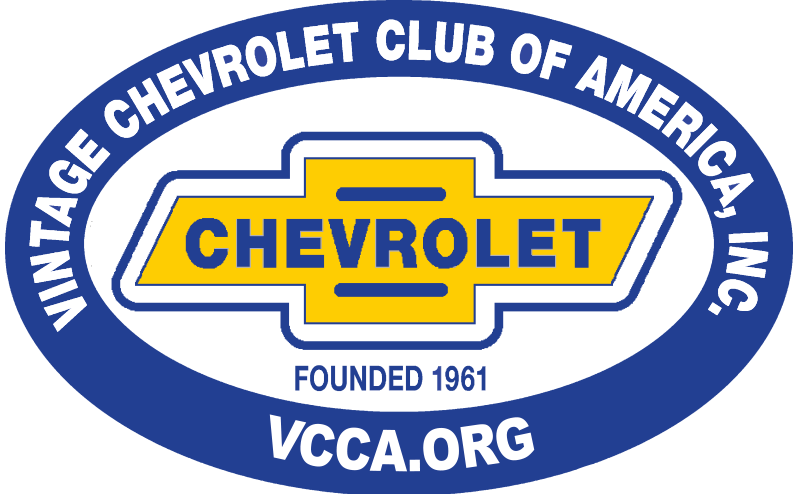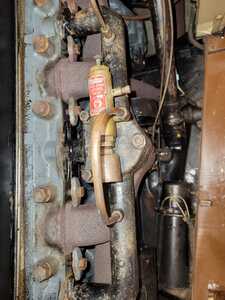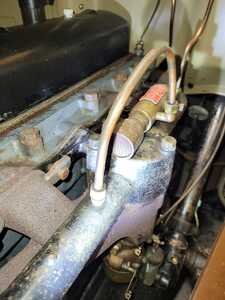This Mallory Fuel-Load Control Valve is on a 1930 Chevy sport coupe. The rest of the vehicle is stock but I am pretty sure this is not. It attaches to the manifold in two places - under the control valve and via the copper pipe "loop" off the side of the control valve. There are two adjustments - one looks like a carburetor metering screw with a spring, the other reminds me of a diaphragm travel screw (on the top of the valve).
What is it's purpose? I cannot find it anywhere on the internet.
The previous owner (my father-in-law), who restored the vehicle beautifully, did not install it and never understood its function. The original owner was a farmer who, when my father-in-law purchased it in 1962, was using the car as a logging vehicle with the rumble seat removed.
Thanks for any help!
Randy
I'm trying to figure out the orientation. I think we're looking down from the top. I don't see it attached to anything but the manifold. Mallory makes fuel valves to this day so I'm thinking something to do with fuel supply but I could be wrong. Is it attached to a fuel line?
7046 old site posts
Save a life, adopt a senior shelter pet
1938 Master Business Coupe
1953 210 Sedan
Yes, the picture is looking from the top from the front of the car. I assumed fuel mix also but there is no connection (or place to connect) to the fuel - just two connections on opposite sides of the manifold. There is a perforated "exhaust" on the bottom of the valve (front of the car s the valve lays horizontal) which looks like a flame arrestor to me...I assume it is air in? I am really baffled as to the purpose.
Hi Randall
I've never seen anything like this.
And I can't say for sure what it does.
But...
Given Mallory's involvement with fuel regulation systems etc to this day as pointed out by Tiny,
and the perforated area that looks like an air intake (possibly a tiny air cleaner as well),
and the adjustable screw that looks like a needle valve as used in a carburetor,
and the attachment to the intake manifold,
I'm thinking that MAYBE it was meant to meter air into the intake manifold under light load (high manifold vacuum) conditions to lean down the mixture for better economy?
Maybe??
Ole S Olson
Saskatoon, Sask, Canada
1946 DR 3/4 ton stake
1139 old site posts
Ole,
I share your thoughts - it seemed to be adding adjustable amounts of air to both sides of the manifold. I am thinking of removing it as it is not original and I am not really interested in economy if it is not addressing a chronic problem with this model car (which, since no one else has ever seen this seems not to be a chronic issue). I'm wondering if the first owner (farmer) was doing a lot of low speed use and had such a need.
I am amazed that there are no pictures or history of this device ANYWHERE and I have pretty much stumped all the 29-32 Chevy groups as well.
Thanks for the input.
Randy
Just a thought but since Mallory is still in business it might be beneficial to contact them with photos and ask them if they can provide some history on the item and it's uses.
7046 old site posts
Save a life, adopt a senior shelter pet
1938 Master Business Coupe
1953 210 Sedan
@Tiny, good thought but, unfortunately, Mallory Electric no longer exists (the one on the internet is a non-auto electrical contractor). It appears that the Mallory name (in ignition and fuel components) has been purchased by several companies since the 60's and now seems to be part of the ACCEL product line but I cannot find contact information even if they had the original Mallory history.
I was able to determine that this Fuel-Load Valve was made in the 1927-1932 range as Mallory moved their manufacturing plant from Toledo to Detroit after that (Toledo OH is embossed on the plate). Being that my car is a 1930, it seems that this valve was installed very early in its history - who knows, maybe even a dealer installed part as it is very professionally tapped into the manifold.
Apparently Mallory Sr was a prolific inventor in his time with lots of patents and gadgets.
But it seems that I am at a dead end short of taking this device apart to figure out how it works and if it is even functioning at all.
Thanks for all the inputs.
Randy
This is pure speculation but is aa way to adjust the car to run better with different loads, altitudes climates etc. without adjusting the carb. I have no real clue but am curious what it is.
Hilton, New York
1941 Chevrolet Master Deluxe
1987 Monte Carlo LS
2001 Chrysler Sebring Convertible




